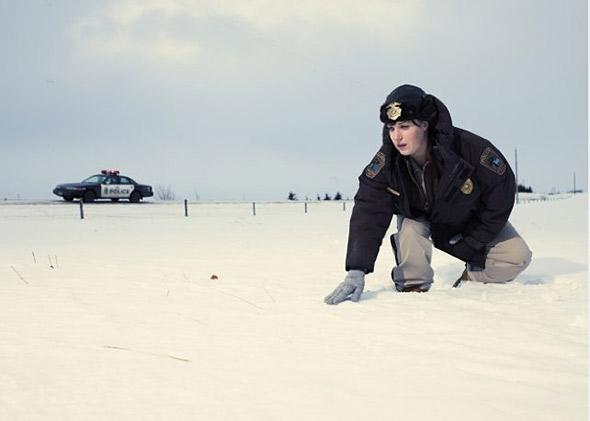Fargo, the TV series, premiering Tuesday night on FX, begins exactly like Fargo, the 1996 Coen brothers film upon which it is based: with a series of title cards that lie to us. “This is a true story,” they read. “At the request of the survivors, the names have been changed. Out of respect for the dead the rest has been told exactly as it occurred.” This is the sort of deadpan, macabre tone that suffuses the film, a darkly comic confrontation between total decency and total depredation—best encapsulated by the movie’s most famous scene, Officer Marge Gunderson (Frances McDormand) finding a professional killer (Peter Stormare) shoving Steve Buscemi’s leg down a wood chipper.
The TV show, which is being imagined as an anthology series like True Detective or American Horror Story with each season telling a contained story, is set in the same universe as the film both thematically and literally. What happened in the movie happened in the world of the series, and here we are, years later, in the Minnesota town of Bemidji, following a cast of Midwesterners who are much, much less polite than they seem.
The Coens gave the project their blessing, and in exchange got a producer credit, but they have had nothing to do with the particulars of the series, all 10 episodes of which have been written by Noah Hawley (whose previous credits include Bones and the very short-lived ABC series My Generation). Fargo the series skimps on decency to revel in the depredation. Hawley, speaking to the New York Times, described the show as “No Country for Old Fargo,” and this is, unfortunately I think, accurate: It is Fargo infested with the spirit of Anton Chigurh instead of Marge Gunderson, as if metaphysical and brutal violence was an underused ingredient in quality TV, instead of the overserved main course.
Martin Freeman, of the original Office and the current Sherlock, stars as Lester Nygaard, a character in the mold of William H. Macy’s Jerry Lundegaard, but one who is a more henpecked, desperate loser. Where Jerry was a hapless sleaze on the make, Lester is a pathetic insurance salesman who is regularly undermined by his own wife. “I guess I married the wrong Nygaard” is standard breakfast table conversation in his house.
Lester encounters Lorne Malvo (Billy Bob Thornton), a hired killer in town on a job. Like Anton Chigurh, Malvo is a hyper-competent, remorseless, intimidating killing machine with an unfortunate haircut. He gives speeches about death and machismo, quotes from the Bible, and spews riddles about how man is prey. In short order, the bodies start to pile up and Malvo is real-talking Lester: “The problem is you spent your whole life thinking there are rules. And there are not. The truth is, you’re more of a man today than you were yesterday.”
Meanwhile, a team of hired killers, Mr. Numbers (Adam Goldberg) and the deaf Mr. Wrench (Russell Harvard), arrive in town, providing some of the comic relief that Buscemi’s and Stormare’s characters did in the film, but much less of the incompetence. Where Fargo, the film, almost scoffed at the idea of the professional hit man and, by extension, the idea that anyone could really control violence, the new Fargo takes both as a given.
The supporting characters are, by and large, nasty. In the film, the violence that occurs is a kind of bolt from the blue, the worst thing that has happened in this modest place. In the series, most of the characters are so sour-hearted, it seems like corruption and violence are an everyday matter. Lester’s brother is a gun nut in possession of all sorts of illegal weapons. The guy who bullied Lester in high school, Sam Hess, is now an abhorrent monster working in the black market. Hess’ wife is crass and money-hungry, and mother to two cruel, mouth-breathing sons. Oliver Platt appears as a blowhard supermarket king who hires Malvo to solve a blackmailing case, which involves his shrill ex-wife and stupidly machinating, spray-tanned trainer (It’s Always Sunny in Philadelphia’s Glenn Howerton).
There is one very good woman among all these cads: police officer Molly Solverson (Allison Tolman), who is the show’s version of McDormand’s Marge Gunderson. Marge, the best thing about the movie, is the character that I missed least in the show, because Tolman is so excellent, matching McDormand’s emotional decency, intelligence, and “you betchas,” and layering the character with some sweet insecurity. But even Molly’s story is more sour than Marge’s. Molly’s incompetent peers are keeping her from solving the case; the state’s institutions, like its citizens, don’t work as they should. She’s also not married—though she has a romantic interest in the show’s other nice guy, single dad cop Gus Grimly (Colin Hanks)—or pregnant: That part of Marge’s storyline gets outsourced to another couple who, needless to say, do not fare as well as Marge and her husband did in the film.
All of these characters and all of these stories frequently add up to something handsome, funny, and weird. But Fargo is missing the spark of originality that would make it great. If you’re going to remake something as concise and self-sufficient as Fargo, there should be a reason, and pointing out that unexpected evil lurks in the hearts of men is not a very good one. For that we have, and I am just barely exaggerating, almost every other drama on television.
